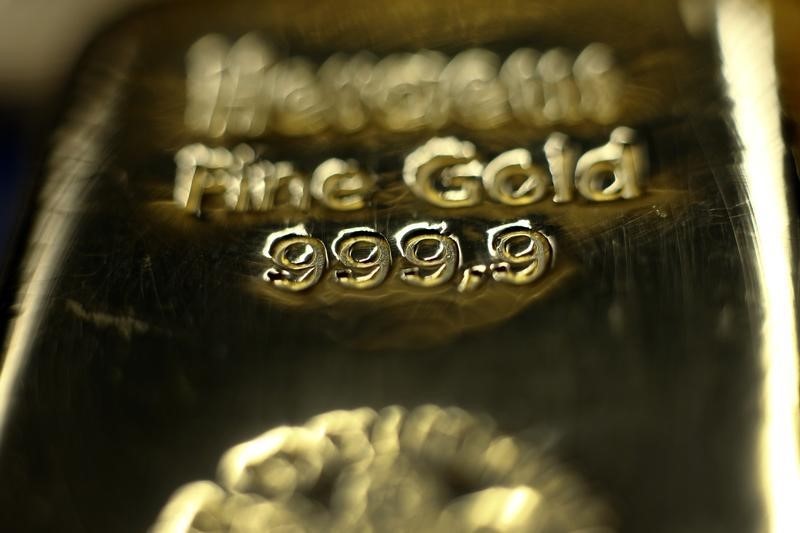Investing.com - Gold futures rallied to a more than six-week high on Friday, as steep losses in global equity markets and receding expectations that the Federal Reserve will raise U.S. interest rates next month boosted demand for the yellow metal.
The Shanghai Composite tumbled more than 4% on Friday, Germany's DAX crashed almost 3%, while the Dow and S&P 500 suffered their worst day since 2011, as fears of a China-led global economic slowdown spooked traders and rattled sentiment.
Gold for December delivery on the Comex division of the New York Mercantile Exchange hit an intraday peak of $1,167.90 a troy ounce on Friday, the most since July 7, before ending at $1,159.60, up $6.40, or 0.55%, for the day.
For the week, prices of the precious metal surged $46.10, or 4.21%, the second straight weekly gain and the biggest weekly climb since mid-January.
Gold fell to a five-and-a-half year low of $1,072.30 on July 24 amid speculation the Fed will raise interest rates in September for the first time since 2006. But prices have since rebounded almost 9% on hopes of a delayed U.S. rate hike.
Some traders believe the U.S. central bank could postpone raising interest rates until December, as officials are likely to remain concerned over weak global growth and inflation pressures due to China’s shock currency devaluation move and plunging oil prices.
A delay in raising interest rates would be seen as bullish for gold, as it decreases the relative cost of holding on to the metal, which doesn't offer investors any similar guaranteed payout.
The U.S. dollar index, which measures the greenback’s strength against a trade-weighted basket of six major currencies, tumbled 1% on Friday to close at 94.84, the weakest level since June 23.
Dollar weakness usually benefits gold, as it boosts the metal's appeal as an alternative asset and makes dollar-priced commodities cheaper for holders of other currencies.
The greenback sold off sharply this week as concerns over the health of the global economy fanned hopes that the central bank could delay raising interest rates till the very end of 2015.
Also on the Comex, silver futures for September delivery dropped 21.6 cents, or 1.39%, on Friday to settle at $15.30 a troy ounce by close of trade. Prices rallied to $15.71 earlier in the day, the most since July 13.
On the week, silver futures tacked on 7.6 cents, or 0.58%, the fourth straight weekly advance.
Elsewhere in metals trading, copper for September delivery shed 1.6 cents, or 0.69%, on Friday to settle at $2.303 a pound. Prices of the red metal sank to a six-year low of $2.260 on Wednesday.
For the week, copper prices slumped 4.1 cents, or 2.04%, as concerns over the health of China's economy and steep declines on Chinese stock markets dampened appetite for the red metal.
The preliminary reading of the Caixin/Markit manufacturing purchasing managers’ index published on Friday fell to 47.1 in August from a final reading of 47.8 a month earlier. It was the lowest reading since March 2009.
The gloomy figure added to concerns over the health of the world's second largest economy.
The Asian nation is the world’s largest copper consumer, accounting for almost 40% of world consumption last year.
In the week ahead, investors will be looking ahead to Wednesday’s data on U.S. durable goods orders for a fresh reading on the strength of the economy. A speech on Monday by Atlanta Fed President Dennis Lockhart will also be closely watched.
Ahead of the coming week, Investing.com has compiled a list of these and other significant events likely to affect the markets.
Monday, August 24
Federal Reserve Bank of Atlanta President Dennis Lockhart is to speak; his comments will be closely watched.
Tuesday, August 25
In the euro zone, the Ifo Institute is to report on German business climate.
The U.S. is to release private sector data on consumer confidence and a report on new home sales.
Wednesday, August 26
The U.S. is to release data on durable goods orders.
Thursday, August 27
The U.S. is to release revised data on second quarter economic growth, as well as the weekly report on initial jobless claims and pending home sales.
Friday, August 28
In the euro zone, Germany and Spain are to publish preliminary data on consumer price inflation.
The U.K. is to release revised data on second quarter economic growth.
The U.S. is to round up the week with data on the goods trade balance, personal income and spending and revised data on consumer sentiment.
